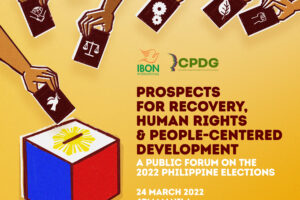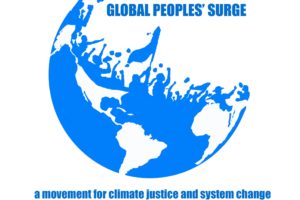IBON International Update #1
[[{“type”:”media”,”view_mode”:”media_large”,”fid”:”589″,”attributes”:{“alt”:””,”class”:”media-image”,”style”:”width: 309px; height: 73px; float: right; margin: 5px;”,”typeof”:”foaf:Image”}}]]
Washington, D.C., October 9—The goal to end extreme poverty worldwide by 2030 is now part of the World Bank Group’s (WB) new vision, adopted at its 2013 Spring Meetings in Washington, D.C. in April. The WB also adds the promotion of “shared prosperity” as another goal. The Bank’s strategy based on this vision is set to be unveiled in the 2013 Annual Meetings on 11-13 October.
At present, the WB estimates that some 20% of the world’s population, or roughly 1.2 billion people, live below the poverty line pegged at $1.25 per person per day. The WB aims to reduce this to 3% by 2030. Meanwhile, it intends to promote the rapid growth of per capita income particularly of the bottom 40% of the populace in developing and transition countries through so-called inclusive growth.
The 2030 goal is familiar as it echoes US President Barack Obama’s promise early this year that “the US will join with our allies to eradicate such extreme poverty in the next two decades.” Likewise the post-2015 process is expected to produce new development goals led by a promise to end extreme poverty by the same year.
But with the Bank’s emphasis on private sector-led economic growth and infrastructure investments through public-private partnerships, as expressed in various policy pronouncements, many are asking: Whose interests will really be served by the new vision and strategy—the world's poor or big business?
WB’s poverty myths
In the Development Committee paper entitled “A Common Vision for the World Bank Group”, the following goals are articulated as a call for both the multilateral institution and the international community:
- End extreme poverty: the percentage of people living with less than $1.25 a day to fall to 3 percent by 2030;
- Promote shared prosperity: foster income growth of the bottom 40 percent of the population in every country.
These goals will be the foundation for a unified World Bank Group Strategy to provide a framework to guide the planning and implementation of its activities. The WB identified five principles that will frame the Strategy, namely:
- Serve the poor and vulnerable people everywhere in a sustainable manner
- Recognize the diversity of clients
- Work as one World Bank Group
- Focus development solutions
- Exercise dynamic selectivity
While the vision paper explaining the goals and principles for its forthcoming Strategy is replete with positive words like “empowerment”, “inclusive” and “sustainable”, the promises made as well as the assumptions and means to achieve these are highly disturbing.
Poverty lines
The World Bank defines the extreme poverty line as $1.25 per day, while the average poverty line in developing countries is $2 per day. Some 1.2 billion people fall below the $1.25 poverty line. Roughly 2.4 billion people live on less than $2 a day.
The Bank admits that while $1.25 is a very meager threshold, it is a well-accepted standard and is the basis of the first Millennium Development Goal (MDG) on reducing global poverty. This poverty line is based on the average of the national poverty lines of the 15 poorest countries and uses purchasing power parities (PPP) dollar. A PPP dollar theoretically buys the same quantity of goods and services in any country. Aside from the narrow basis (15 countries) for an international standard, critics also question the use of PPP dollar as its calculation is based on international baskets of goods that do not reflect the consumption behavior of poor households.
Illustrative of the contentious nature of the Bank’s poverty measurement, critics cite the “Black Monday” of poverty reduction—26 August 2008—when 430 million more people were suddenly plunged into poverty not because of a catastrophe but because the WB changed its poverty line from $1.08 to $1.25 due to rising criticism. Indeed, current money-based measurements of poverty show the tendency to underestimate global poverty. Several other indicators point to the breadth and depth of deprivation in the world today—some 3 billion people use wood, charcoal, coal and dung for cooking and heating; over 1.3 billion people are without electricity; about 2.5 billion do not have safe sanitation; and 783 million people have no safe drinking water.
Optimism from MDG 1
According to the WB, the first MDG on reducing global poverty was achieved in 2010, five years ahead of schedule, with 21% of people in developing countries who lived at or below $1.25 a day (down from 43% in 1990 and 52% in 1981).
But such declaration was based on rough estimates from few data sets available and largely due to China. Almost all the decline since 1981 is from China, which pulled 680 million people from the quagmire of poverty, reducing extreme poverty from 84% in 1980 to just 10% at present.
Meanwhile, the number of people living below $1.25 a day outside China such as Sub-Saharan Africa even increased during the period. In 2008, 386 million people were living in absolute poverty in Sub-Saharan Africa—96 million more compared with 1990 figures.
Target 2030
To reach the 2030 target of reducing the extreme poverty rate to 3%, the world will have to witness a decline in poverty by about one percentage point per year, or about the same average annual reduction since 1980, according to the WB. This implies maintaining a growth rate of per capita household income in developing countries at least as high as levels recorded since 1999.
The Bank anticipates the tough challenge ahead citing the prevailing high rates of extreme poverty in many countries, impacts of climate change, fragile and conflict-affected situations, among others, to highlight that the goal is a difficult ambition. Indeed, it will be harder to produce the numbers in the next 15 years without a repeat of China’s feat.
Critics also point out that the same goal of eliminating extreme poverty was set 40 years ago by then WB president Robert McNamara and the target date was year 2000. It seems that this is a moving goalpost for the WB and the historic opportunity it is proclaiming now also appears to have already occurred several times. For instance, in 2005, UK Prime Minister Tony Blair said, “We do have an historic opportunity this year to make poverty history.” Much earlier, in 1964, US president Lyndon Johnson also declared, “For the first time in our history, it is possible to conquer poverty.”
A question of sharing?
Accompanying the goal to end abject poverty is the promotion of “shared prosperity” by raising the incomes of the poor and vulnerable. The WB is set to monitor the progress in shared prosperity using the income growth of the bottom 40% of a country’s population. A new Shared Prosperity Indicator is set to launch later this year, which will purportedly help countries observe if they are able to reduce inequality over time. The measure, according to the Bank, “captures the twin elements of shared prosperity: the importance of economic growth matched with a strong concern for equity.”
But tackling inequality is not just about sharing, especially not of the crumbs from the top. What about the insatiable accumulation of those comprising the highest income groups? In addressing inequality, looking at the bottom is not enough; the unbridled growth at the top must also be reined in and appropriate redistributive measures applied.
The WB’s “shared prosperity” concept in fact accepts the rise of inequality as a necessary by-product of generating growth. According to the Bank, “A singular focus on inequality can even be counterproductive for the poor in the short run.” It argues that an increase in inequality is consistent with growth generation, which rewards investors for innovation and risk-taking.
Inclusive growth defined
The Bank’s vision of prosperity “requires rapid and broad-based growth” anchored on private sector growth and contribution. It calls for “inclusive green growth” that supposedly reconciles rapid growth with environmental sustainability. And who will be central to this green growth? The private sector or, more accurately, big business.
As the WB says so itself, “A key element of our work is to promote the private sector as a critical driver of jobs, goods, and services to improve the lives of the poor through inclusive and sustainable growth.” Developing country governments, on the other hand, are urged to create an enabling environment for economic growth by improving competitiveness, promoting a favorable investment climate, and encouraging innovation.
New strategy or new excuses?
The 2013 Annual Meetings of the WB Group and International Monetary Fund (IMF) from October 11 to 13 will reveal the new Strategy developed using five principles as its “building blocks”. The first principle on serving the poor and vulnerable everywhere supposedly updates the existing approach based on outdated poverty profiles. The WB notes that many of the poor are in middle-income countries. Thus, in recognition of this, “the World Bank Group will serve poor and vulnerable people in all countries: large, medium, and small, across the spectrum of income levels and institutional capacity.” While this is nothing new as the WB dispenses loans to big or small developing countries, it now officially diffuses the focus of development assistance and justifies its presence in well-off, thus more profitable, countries and sectors.
The next principle, on recognizing the diversity of WB clients, highlights its service to the private sector for which the International Finance Corporation (IFC) and the Multilateral Investment Guarantee Agency (MIGA) are taking the lead role. Strong criticisms are hounding the Bank on many areas of public goods where its response has been privatization, such as in water utilities and other social services, negatively impacting access and rights of the very poor it professes to benefit. Likewise, the principle of working as one WB Group has alarmed analysts following the Bank's work as this can mean the dominance of IFC's investor-friendly precepts and practices in the whole Bank operations.
As it positions itself as a “solutions” Bank, the WB promises to focus on development solutions by emphasizing “what works” and “how best to deliver it” as well as exercise dynamic selectivity. Such seemingly pragmatic approach does not bode well for much more meaningful human rights-based or social justice approaches. Clearly, the WB is striving to make itself useful and relevant not to the world's poorest but to the competitive markets and big players it has now openly admitted catering to.
It comes as no surprise that although the WB has existed for almost seven decades now, it has failed to promote genuine development and reduce poverty. The vast number of people trying to survive with less than $1.25 a day, and the even bigger number of the world’s population who barely subsist on daily incomes above this threshold of extreme poverty, illustrate the magnitude and complex forms of global poverty and the failure of business-as-usual approaches. And yet, as in the past, the WB remains a champion of private capital, pushing for limitless growth in an ever-polarized world of haves and have-nots and exacerbating economic, social, political and other inequalities.



